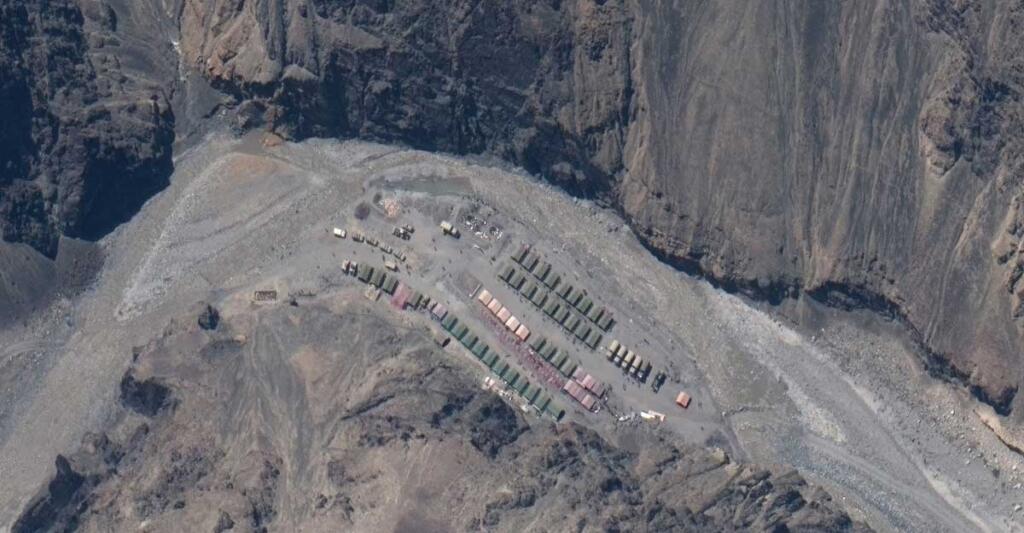Recent satellite images have exposed China’s extensive military infrastructure development in eastern Ladakh’s Pangong Lake area. This region, unlawfully occupied by China since former Prime Minister Jawaharlal Nehru’s era, has undergone significant changes lately. China’s actions have raised concerns about regional stability and the balance of power along the disputed border.
China’s Base at Sirjap
The People’s Liberation Army (PLA) of China has set up a base at Sirjap, on Pangong Lake’s northern shore. This base, in territory India claims, serves as the command center for Chinese forces nearby. Notably, this area was mostly uninhabited before the 2020 border tensions erupted. The base’s location, about 5 km from the Line of Actual Control (LAC), highlights China’s aggressive stance in the region.
Underground Facilities and Defensive Structures
Built between 2021 and 2022, the base boasts impressive underground bunkers for storing weapons, fuel, and supplies. Satellite images reveal multiple entrances to these bunkers, along with buildings for operations and shelters for armored vehicles. Furthermore, the base features artillery positions and an extensive network of roads and trenches. These developments show China’s commitment to establishing a long-term military presence in the area.
China’s Infrastructure Advantage
A former Indian Army commander highlighted China’s superior infrastructure, noting the absence of similar underground shelters on the Indian side. He stressed the importance of such structures for protecting military assets from air strikes. “Without underground shelters, weapons and stores are sitting ducks for air strikes with precision-guided munitions,” he explained. The commander added that China excels in tunneling activities, which don’t require high-tech solutions but rather civil engineering skills and funding.
India’s Response to China’s Activities
In response to China’s actions, India has stepped up its border infrastructure development. This includes constructing roads, bridges, tunnels, and improving facilities for soldiers. The Border Roads Organisation has completed numerous projects, including the strategic Sela tunnel in Arunachal Pradesh. India’s focus has been on enhancing living conditions for troops and protecting weapons and equipment in forward areas.
India’s infrastructure push has been driven by increased spending and swift execution of strategic projects. In the 2023-24 fiscal year alone, the Border Roads Organisation completed 125 infrastructure projects valued at Rs 3,611 crore.
China’s Air Force Deployments
Alongside the Pangong Lake developments, China has boosted its military presence at the Shigatse air base in Tibet. Satellite images have shown advanced fighter jets, including J-20 stealth aircraft and J-10 jets, at this base. Experts believe these deployments aim to counter India’s Rafale jets stationed at the nearby Hasimara base in West Bengal.
The Shigatse base, about 300 km from India’s Hasimara base, houses a squadron of Rafale combat jets. China’s deployment of J-20s to Tibet, moving them from coastal and inland provinces, underscores the region’s strategic importance in China’s military planning.
China’s Activities in Doklam
On the Doklam plateau, China maintains a network of roads linking military infrastructure along the disputed border. Recent satellite imagery has revealed a significant presence of military vehicles in both rear bases and forward positions. These developments in Doklam, the site of a tense standoff in 2017, indicate China’s ongoing efforts to strengthen its position in this strategically important area.
Implications
China’s military expansion in these contested regions highlights the ongoing tensions between China and India. As China continues to strengthen its position, India faces the challenge of responding effectively while maintaining regional stability. The developments at Pangong Lake, Shigatse, and Doklam collectively demonstrate China’s multi-pronged approach to asserting its territorial claims and military prowess along the disputed border.
In conclusion, China’s aggressive infrastructure development and military deployments in the region pose significant challenges for India and other neighboring countries. As China bolsters its presence in these contested areas, the international community watches closely, recognizing the potential impact on regional security and geopolitical dynamics.
